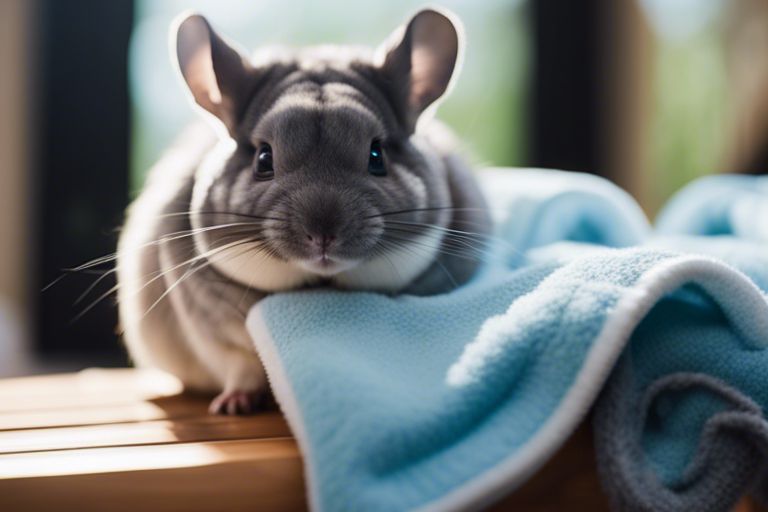Chinchillas have dense fur that can easily become waterlogged, putting them at risk of hypothermia and respiratory infections if they get wet. Drying a wet chinchilla requires immediate action and careful handling to ensure their safety and comfort. Below, we outline the best methods and precautions to follow when drying a chinchilla, as well as aftercare tips to maintain their health.
Key Takeaways
- Immediate Action: Dry a wet chinchilla immediately to prevent health risks like hypothermia.
- Gentle Towel Drying: Use soft towels to absorb excess moisture without causing stress or damage to their fur.
- Warm Environment: Ensure the chinchilla is placed in a warm, draft-free space to dry completely.

Steps to Dry a Wet Chinchilla
1. Prepare Drying Supplies
Before starting, gather the following items to ensure a smooth drying process:
- Soft, absorbent towels (e.g., microfiber or cotton hand towels).
- Warm, draft-free space (such as a small room or enclosure).
- Bedding material to provide additional warmth and absorb remaining moisture.
Having these supplies ready ensures the process is efficient and minimizes stress for your chinchilla.
2. Towel Drying Techniques
The safest and most effective method for drying a wet chinchilla is using towels:
- Gently pat the chinchilla with a clean, soft towel to absorb moisture. Avoid rubbing or tugging at their fur, as this can damage their coat and cause unnecessary stress.
- Replace wet towels as needed to continue drying without reintroducing moisture.
- Focus on drying the body thoroughly but handle sensitive areas like the ears and face with extra care.
3. Air Dry in a Warm Environment
Once you’ve removed as much moisture as possible with towels:
- Place the chinchilla in a warm, draft-free area to air dry completely.
- Provide soft bedding to help wick away remaining moisture while keeping them comfortable.
- Monitor the environment to ensure it is warm but not excessively hot, as chinchillas are sensitive to extreme temperatures.
4. Optional: Use a Hair Dryer Safely
If your chinchilla is still damp after towel drying and air drying, a hair dryer can be used with caution:
- Set the dryer to a cool or low heat setting to avoid overheating their delicate skin.
- Maintain a safe distance (at least 6 inches) between the dryer and the chinchilla.
- Use a diffuser attachment to distribute airflow evenly and reduce noise, which can stress your pet.
- Continuously monitor their reactions and stop immediately if they show signs of distress.
Drying Tools, Methods, and Precautions
| Method | Steps | Precautions |
|---|---|---|
| Towel Drying | Pat gently with a soft towel | Avoid rubbing to prevent fur damage |
| Air Drying in Warm Area | Place in a draft-free space with bedding | Ensure area is free of cold drafts |
| Hair Dryer (if needed) | Use on cool, low setting with a diffuser | Keep at least 6 inches away from the skin |
Aftercare: Ensuring a Healthy Recovery
Monitor for Signs of Illness
After drying, observe your chinchilla closely to ensure they return to their normal behavior:
- Watch for unusual symptoms, such as sneezing, coughing, lethargy, or loss of appetite.
- If any concerning signs appear, consult a veterinarian immediately.
Maintain Healthy Fur
Chinchillas rely on their fur for insulation and protection, so keeping it healthy is essential:
- Provide regular dust baths using high-quality volcanic ash dust to absorb oils and maintain fur integrity.
- Avoid bathing them in water, as their fur is not suited to getting wet.
- Brush gently if their fur appears matted after drying to restore its natural fluffiness.
Conclusion
Drying a wet chinchilla is a delicate process that requires immediate action and careful handling. Begin by patting them dry with a soft towel, then allow them to air dry in a warm, draft-free space. Avoid high heat sources like heating pads or hair dryers on high settings, as these can harm your pet. Monitor your chinchilla closely after drying to ensure their well-being and maintain healthy fur through regular grooming and dust baths.
By following these steps, you can safely and effectively care for your chinchilla in the event they get wet, protecting their health and comfort.
FAQ
Q: Why can’t chinchillas get wet?
A: Chinchillas have dense fur that traps moisture, making it difficult to dry completely. This can lead to hypothermia or respiratory infections.
Q: Can I use a heating pad to dry my chinchilla?
A: No, heating pads can easily overheat your chinchilla and cause burns. Stick to towels and warm, draft-free environments.
Q: How long does it take to dry a chinchilla?
A: Depending on the method, it may take 1-2 hours for a chinchilla to dry completely. Monitor them during this time to ensure they stay warm and stress-free.
Q: What should I do if my chinchilla resists being dried?
A: Remain calm and patient. Use soft, reassuring touches and ensure the drying process is as quick and gentle as possible.
